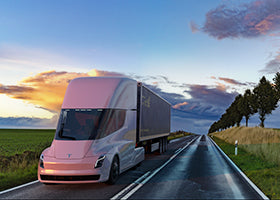
By Braden Cooper, Product Marketing Manager
In today’s high-performance computing technological landscape, there is a stark contrast between the compute capabilities of enterprise hardware in datacenters and low-performing embedded systems in edge and transportable environments. The autonomous trucking industry in particular has seen a growing need for higher performance compute, storage, and networking solutions in its rugged edge environments. While size, weight, and power (SWaP) optimized embedded systems are the long-term objective of the industry, current autonomous trucking development platforms require access to high levels of compute to avoid any bottlenecks imposed upon their critical software developments. When looking to solve the developmental compute need of the autonomous truck industry through enterprise hardware – there are some important factors to consider.
Lastly, as the autonomous vehicle market in general continues to develop, the governing bodies and regulatory agencies continue to define laws regulations, and qualification requirements for the vehicles. The impact on leading autonomous truck integrators will be massive in the coming years as regulations change and mature with vehicle experience and new findings. When it comes to adopting high-performance computing hardware into autonomous trucks, certain elements must be carefully considered such as the flexibility and modularity of the compute system designs. As industry standards are defined, modifications to the electronics and the corresponding regulatory testing of the electronics is a key expertise to have. Over the next several years, the autonomous truck compute integrators which can navigate shifting compliance standards most efficiently will have a strong advantage over their competition. This efficiency will come from flexible system designs, robust qualification test plans and execution, and a strong understanding of current and future regulatory standards.
Ultimately, integrating enterprise high-performance computing electronics into autonomous trucks is an important step in the current development cycle of the industry. By using datacenter level compute capacity, software developments can accelerate without constraints or bottlenecks in the system architecture. Integrating mechanically optimized rugged servers also mitigates the challenges introduced by edge environmental conditions of autonomous trucks. This hardware also provides a long-term roadmap in terms of scalable compute performance as new technologies are introduced over the next several years. OSS offers a product portfolio of compute, storage, and networking systems optimized for the autonomous trucking industry’s current and future needs.
Click the buttons below to share this blog post!

By: Jaan Mannik – Director of Commercial Sales
The term AI, or Artificial Intelligence, is everywhere nowadays and has quietly woven itself into the fabric of our daily lives. It powers the recommendations we see on streaming platforms, the navigation apps that guide us through traffic, and even the virtual assistants that answer our questions in seconds. From optimizing energy use in smart homes to predicting market shifts in finance, AI has become the invisible engine driving convenience, efficiency, and insight across industries.
In manufacturing, AI-driven robots collaborate with humans to streamline production. In agriculture, machine learning models monitor crops, forecast yields, and conserve resources. Retailers use predictive analytics to anticipate consumer needs before customers even express them. The reach of AI is no longer confined to futuristic labs, it’s in our phones, vehicles, and cities, constantly learning and adapting to serve us better.

OSS PCIe-based products deliver critical advantages for modern military sensor systems by enabling real-time data acquisition, processing, and transmission in rugged, mission-critical environments. These benefits stem from their ability to support high-bandwidth, low-latency interconnects, modular scalability, and environmental resilience, all of which are essential for today’s advanced military platforms.

Companies today are being asked to do more with data than ever before. Bigger AI models, faster insights, and workloads that don’t stay in one place, it’s a lot to keep up with. Traditional infrastructure just isn’t built for this kind of speed and flexibility.
The answer isn’t about throwing more hardware at the problem. It’s about building smarter, more agile infrastructure that adapts as demands change. And that’s where scale-out and increasingly, a blend of scale-out and scale-up come into play.